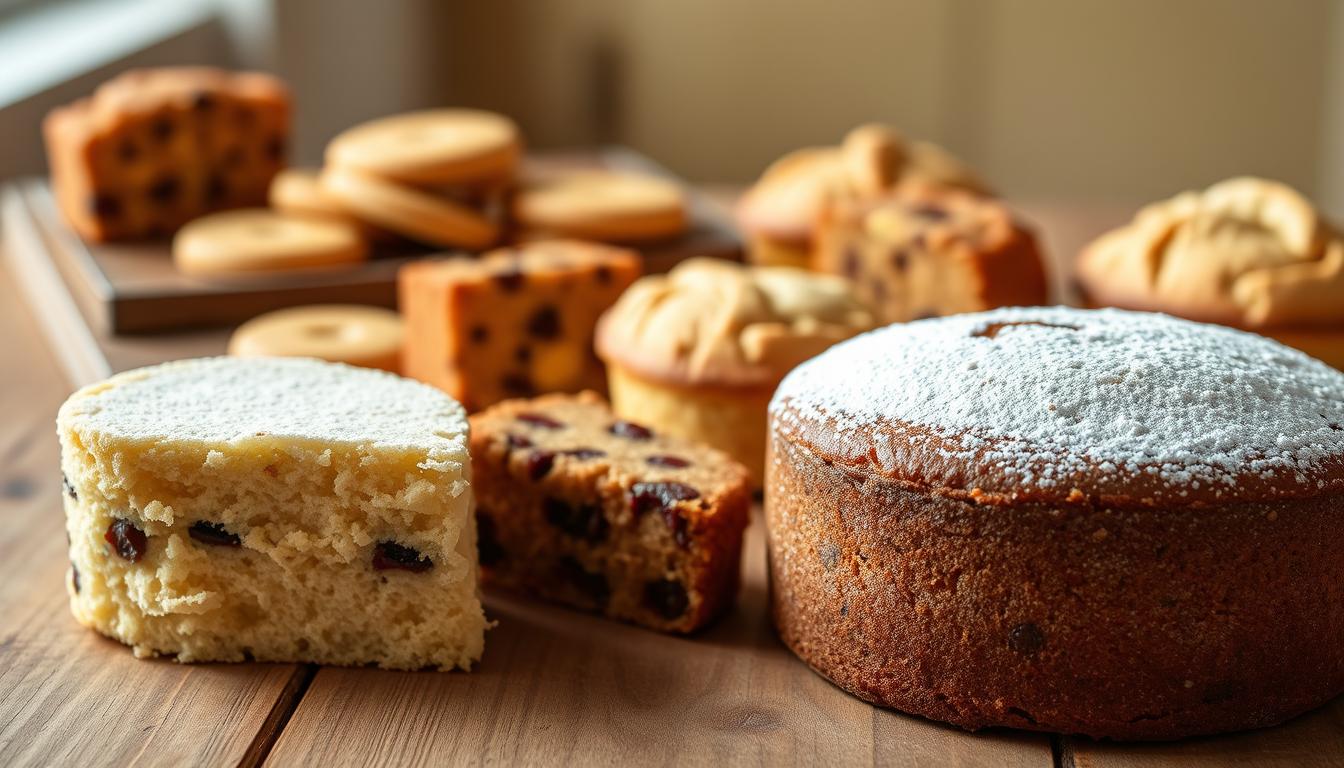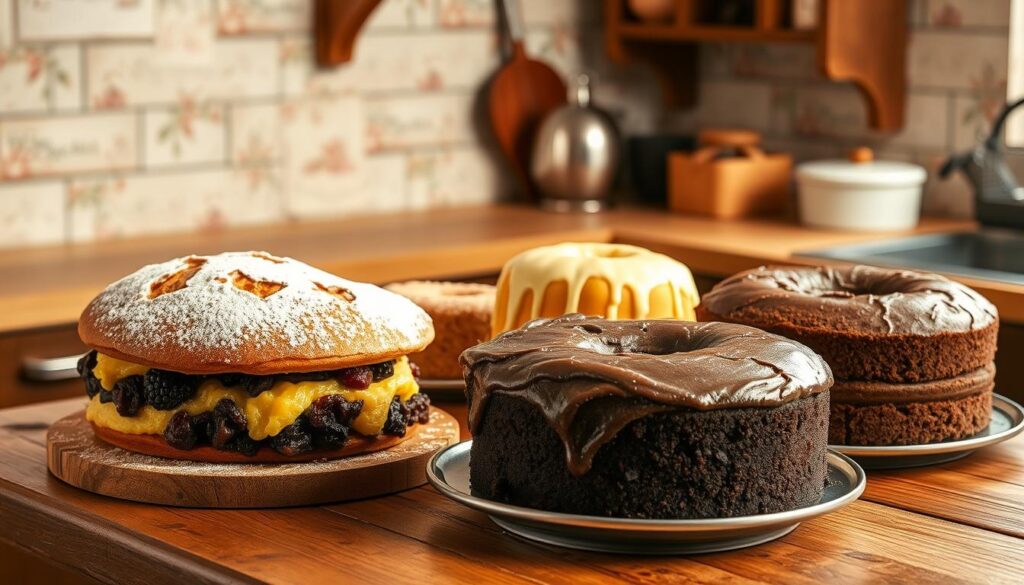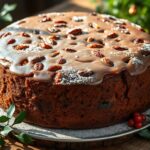As I mix flour and sugar, memories of my grandmother’s kitchen come alive. The smell of cakes baking there was unforgettable. Traditional British cake recipes are more than just recipes; they’re a call to explore baking, even for kitchen newbies. If you love the idea of a warm sponge cake with cream, this is your adventure.
In this article, we’ll dive into the magic of classic British cakes made simple for beginners. We’ll discover recipes that capture British tastes, helping you make treats that taste great and bring back memories. So, get ready to bake with excitement and confidence!
Key Takeaways
- Traditional British cake recipes are cherished for their rich flavors and textures.
- These classic British cake recipes can be easily mastered by beginners.
- Baking evokes nostalgia and comfort, making it a worthwhile experience.
- Simple recipes encourage exploration and creativity in the kitchen.
- All you need are basic ingredients and a bit of enthusiasm to start baking.
Introduction to British Baking
British baking is a journey into the UK’s rich history and diverse culture. Over centuries, it has grown, shaped by local ingredients and traditions. Each region has its own special recipes and methods, creating a vast collection that excites many home bakers.
Traditional British cake recipes are special because they’re at the heart of celebrations and daily life. A classic Victoria sponge for tea or a rich fruit cake for holidays tells a story of British heritage. In my kitchen, these cakes remind me of warmth, community, and a bit of nostalgia.
British baking shows the wide range of flavors and textures you can make with simple ingredients. With just flour, eggs, sugar, and butter, you can create many treats. These treats not only taste great but also make baking a fun and rewarding hobby. It’s a way to explore traditional treats and share them with those we love.
| Feature | Description |
|---|---|
| History | Rich heritage spanning centuries, with each recipe telling a unique story. |
| Diversity | Variety of regional specialties, showing local ingredients and traditions. |
| Accessibility | Simple ingredients make it easy for anyone to bake delicious traditional cakes. |
| Community | Baking brings people together, often sharing with friends and family. |
The Charm of Traditional British Cakes

Traditional British cakes are loved for their rich flavors and textures. Each cake tells a story, showing Britain’s culture and history. Classic recipes like Victoria sponge, Battenberg, and Eccles cake mix simplicity with sophistication.
The Victoria sponge is a hit at afternoon tea for its lightness. It’s easy to make, perfect for beginners. The buttercream or jam in the middle adds a burst of flavor, making it even more special.
Battenberg is known for its checkered pattern and almond flavor. It’s wrapped in marzipan, making it a favorite for celebrations. Every slice shows the care that goes into these traditional recipes.
Eccles cakes are a treat with their flaky pastry and sweet filling. They capture the essence of British baking. Each bite brings back memories and connects us to our heritage.
The beauty of British cakes is in the memories they make. Baking them lets us join a tradition that welcomes all. It’s a chance to enjoy a wonderful experience, whether you’re new to baking or have years of experience.
| Cake Name | Main Flavor | Notable Ingredient |
|---|---|---|
| Victoria Sponge | Light and buttery | Jam |
| Battenberg | Almond | Marzipan |
| Eccles Cake | Sweet and fruity | Currants |
Essential Ingredients for British Cakes

Starting with traditional British cake recipes for beginners means knowing the key ingredients. These parts add flavor and texture to the cakes. They also make baking more enjoyable. Self-raising flour is a must-have. It has flour, baking powder, and salt, making cakes rise perfectly without extra leavening.
Butter, preferably unsalted, is next on the list. It brings a rich taste and keeps the cake moist. Choose high-quality butter for the best flavor. Eggs are also vital; they add structure, moisture, and richness. Always use fresh eggs for the best results.
Sugar balances the cake’s flavors. Granulated sugar is common, but brown sugar adds a special taste to some cakes. I focus on using fresh, quality ingredients. Finding these can be tough, but local markets and organic stores have great options.
Simple British Cake Recipes

Baking at home is fun, thanks to simple British cake recipes. These recipes are easy to follow, perfect for beginners. The classic pound cake is a favorite of mine. It needs just a few ingredients and tastes amazing with every bite.
The basic chocolate cake is another great choice. It uses cocoa powder and flour for a moist, rich dessert. Here’s a comparison of these two recipes, showing their main ingredients and preparation notes.
| Recipe | Main Ingredients | Preparation Time | Baking Time |
|---|---|---|---|
| Pound Cake | Butter, sugar, eggs, flour | 15 minutes | 60 minutes |
| Basic Chocolate Cake | Cocoa powder, butter, sugar, flour, eggs | 20 minutes | 30 minutes |
These recipes are not only tasty but also inspire creativity. I like to add fruit or nuts for a unique twist. Baking should be enjoyable and creative, and these recipes make it easy to get started.
Traditional British Cake Recipes for Beginners

Exploring traditional British cake recipes is a delightful journey. These recipes are not just tasty treats but also great learning tools for beginners. They offer a range of options that are easy to make and very rewarding.
Overview of Popular Recipes
Some traditional British cakes are favorites among beginners. Here are a few:
- Lemon Drizzle Cake – A zesty and moist cake, perfect for those leaning towards citrus flavors.
- Rich Fruit Cake – This classic is ideal for festive occasions and provides a dense flavorful experience.
- Sponge Cake – Light and fluffy, sponge cakes are great for layering with cream and fruits.
Why These Recipes are Great for Beginners
These traditional British cake recipes are great for beginners for several reasons:
- They use simple ingredients, making them easy to find and use.
- The step-by-step instructions are clear, helping beginners bake smoothly.
- These recipes let you get creative with flavors and decorations.
Starting with these recipes helps beginners gain confidence and skills in the kitchen. They get to enjoy some of the best British cakes while learning.
Classic British Sponge Cake Recipe

Baking a classic British sponge cake is fun and easy for anyone. This traditional recipe is simple yet rewarding. First, you’ll need these key ingredients:
| Ingredient | Quantity |
|---|---|
| Unsalted Butter | 1 cup (about 226g), softened |
| Granulated Sugar | 1 cup (about 200g) |
| Large Eggs | 4, at room temperature |
| All-Purpose Flour | 1 cup (about 125g) |
| Baking Powder | 1 tsp |
| Milk | 2 tbsp |
Here’s how to make a delicious sponge:
- Preheat your oven to 350°F (175°C) and grease two 8-inch round cake pans.
- In a bowl, cream together the softened butter and sugar until light and fluffy.
- Add the eggs one at a time, beating well after each addition.
- In a separate bowl, sift the flour and baking powder together.
- Gradually incorporate the dry ingredients into the wet mixture, folding gently.
- Stir in the milk to achieve a smooth batter.
- Divide the batter evenly between the prepared pans and bake for 25-30 minutes, or until the cakes are golden and a toothpick inserted into the center comes out clean.
- Let the cakes cool in the pans for 10 minutes before transferring them to a wire rack to cool completely.
Don’t be afraid to get creative! You can add flavors like vanilla, lemon, or chocolate. Chopped fruits or a layer of jam between the sponge layers can make it even better.
Easy British Cake Recipes to Start With

Starting with easy British cake recipes is very rewarding. These beginner-friendly cakes let anyone jump into baking without stress. Each recipe has simple steps that make baking fun.
The classic vanilla cake is a favorite of mine. It’s a traditional British treat with a soft, fluffy texture. It’s great for beginners because it uses basic ingredients.
Muffins are another quick and easy option. They’re perfect for beginners because they’re simple to make. You can try different flavors like blueberry or chocolate chip. This way, you can enjoy many tastes without getting too complicated.
Whether you’re making vanilla cake or muffins, these recipes are great for learning. They help you build skills and encourage you to try new things. Baking is all about enjoying the process and trying new recipes.
Tips for Perfecting Your Bake

Baking can be both fun and challenging for beginners. To get better at traditional British cake recipes, I’ve gathered some helpful tips. A bit of preparation and knowing common mistakes can greatly improve your baking.
Common Mistakes to Avoid
- Overmixing: It’s tempting to mix batter thoroughly, but overmixing can lead to tough cakes.
- Not Preheating the Oven: Preheating is vital for even baking, so ensure your oven is ready before placing your cake inside.
- Ignoring Ingredient Temperatures: Using ingredients at room temperature helps with better mixing and rising.
- Not Measuring Accurately: Precision is critical; invest in good measuring cups and spoons to enhance the accuracy of your recipes.
Tools You’ll Need for Baking
Having the right tools is key when baking traditional British cake recipes for beginners. Here’s a list of essentials:
| Tool | Purpose |
|---|---|
| Mixing Bowl | For combining ingredients efficiently. |
| Measuring Cups | Essential for accurate ingredient amounts. |
| Whisk | Perfect for mixing batter smoothly. |
| Baking Tray | A quality tray ensures proper heat distribution. |
| Spatula | Great for folding and transferring batter. |
British Fruit Cake Recipe for Beginners

If you’re new to British baking, try this classic fruit cake recipe. It’s a mix of tradition and simplicity. The fruits, nuts, and spices give it a rich taste, perfect for any event.
To start, collect your ingredients:
- 1 cup mixed dried fruits (such as raisins, cranberries, and cherries)
- 1 cup mixed nuts (chopped, such as almonds and walnuts)
- 1/2 cup unsalted butter
- 1 cup brown sugar
- 2 large eggs
- 1 cup all-purpose flour
- 1 teaspoon baking powder
- 1 teaspoon ground cinnamon
- 1/4 teaspoon salt
- 1/4 cup milk
Now, let’s make the cake:
- Preheat your oven to 325°F (163°C) and grease a round cake pan.
- Melt the butter in a saucepan over low heat, then stir in the brown sugar until smooth.
- Remove from heat and let it cool slightly. Beat in the eggs, one at a time.
- In a mixing bowl, combine flour, baking powder, cinnamon, and salt. Gradually add this to the wet mixture.
- Fold in the mixed dried fruits and nuts.
- Pour the mixture into the prepared pan and smooth the top.
- Bake for about 50-60 minutes, or until a toothpick inserted in the center comes out clean.
- Allow the cake to cool in the pan for 10 minutes, then transfer to a wire rack to cool completely.
Letting the cake mature for a few days will make it even tastier. This recipe is a great start to traditional British cakes. Enjoy making it and relish the delicious result!
Baking Techniques for Beginners

Baking can seem tough at first, but learning a few key techniques makes it easier. One important skill is creaming butter and sugar. This makes a light base that adds air to your cakes.
Folding ingredients is another must-know. It’s a gentle way to mix in things like egg whites or flour. This keeps your mix airy, just like British cakes.
Knowing your oven’s temperature is key. Every oven is different, so getting to know yours is important. Preheating helps your cakes bake evenly.
Mastering these techniques not only improves your baking but also deepens your love for British baking. It makes baking fun and less scary. You’ll enjoy every step in the kitchen.
Conclusion
Baking is a mix of skills and creativity, and it’s really fun. Seeing your cake rise and smelling its aroma is very rewarding. Whether you’re making simple or complex cakes, each time you bake, you get better and express yourself.
These recipes are just the beginning. They let you try new flavors and techniques. I suggest everyone give these classic recipes a try. Adding your own twist can make the flavors even better.
The kitchen is a place for learning and trying new things. With every bake, you’ll become more confident and skilled. So, get your ingredients ready, preheat the oven, and dive into the world of British baking!
FAQ
What are some traditional British cake recipes suitable for beginners?
Great options for beginners include the classic Victoria sponge, lemon drizzle cake, and pound cake. These recipes are easy to follow. They offer delicious results that capture authentic British flavors.
Can you recommend any easy British cake recipes for someone just starting out?
Absolutely! Quick muffins and chocolate cake are perfect for beginners. They need minimal ingredients and are forgiving in technique. This makes them fun to bake.
What makes the British sponge cake recipe suitable for new bakers?
The traditional British sponge cake recipe is simple. It uses basic ingredients like flour, eggs, and sugar. It’s a great introduction to baking, teaching fundamental techniques without being too detailed.
Are there specific tips for making a British fruit cake as a beginner?
When making a British fruit cake, choose quality dried fruits and let the cake mature for better flavor. Follow the recipe step-by-step and ensure ingredients are at room temperature. This will help you succeed.
What essential ingredients should I have for British baking for beginners?
You’ll need self-raising flour, butter, eggs, and sugar. These ingredients are key in many traditional British cake recipes. Using high-quality versions will improve your baking results.
How do I avoid common mistakes when trying classic British cake recipes?
Avoid mistakes like not measuring ingredients accurately and overmixing the batter. Read the recipe thoroughly before starting. Take your time during mixing.
Can you suggest simple British cake recipes suitable for special occasions?
Sure! Lemon drizzle cake or a rich fruit cake are great for celebrations. They offer a delightful taste and impress guests. Both recipes are easy for beginners to make.
What tools do I need for British baking?
Beginners need mixing bowls, measuring cups, baking trays, and an oven thermometer. These tools ensure you have everything needed to make traditional British cakes.
How can I experiment with flavors in my British cake recipes?
Experiment by adding different flavors or fruits to your basic sponge recipe. Vanilla extract, almond essence, or fresh berries can make your cake unique and delicious!


